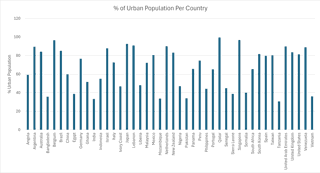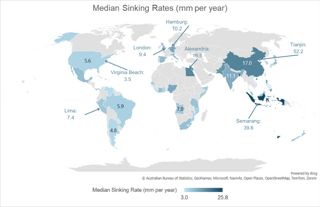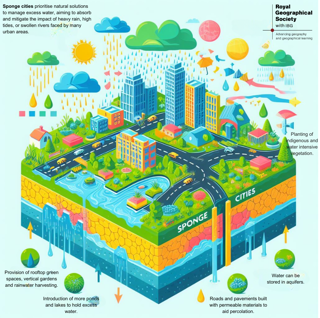Introduction
With the escalating pace of urbanisation around the world, cities face unprecedented challenges in accommodating their expanding populations. Common issues such as traffic congestion, pollution, insufficient housing, and inadequate waste management are all too familiar in most urban areas.
However, in addition to the usual challenges faced, some cities are also under threat from another problem – they are sinking! Not only does this pose a practical challenge in terms of urban planning but also, with the increase of extreme weather events and rising sea levels, flooding is also a concern in many urban areas that are sinking.

Take Venice for instance, being built on a coastal lagoon, some parts of the city are only 55cm above sea level. The residents of this ancient city are no strangers to the threat of flooding and have made provisions to help prevent further damage to infrastructure. For example, managing tourist numbers through an access fee which was introduced on 25th April 2024. However, on 12th November 2019, the city was hit by a storm surge of over 1.8 meters high - flooding more than 80% of the city. This event underscores the pressing reality: with eustatic changes (global sea level fluctuations) on the horizon, some coastal urban centres face escalating vulnerability to sinking. Moreover, the compounding factors of isostatic shifts (localised rise or fall in land levels) and human activities further compound this risk, reverberating across many cities including ones found inland.

In this edition of geography in the news we explore how and why different cities are sinking as well as how some are attempting to mitigate the effects.
China: Tianjin
Urban-like areas in China date back to over 4000 years ago. However, it wasn't until the 1990s that China experienced rapid urbanisation. Today, over 60% of the population of China live in urban areas (Statista, 2023).
Rapid urbanisation has caused many issues, chief among them being the notorious high smog levels plaguing cities like Beijing and Shanghai. However, a staggering 45% of all urban areas in China are sinking by three millimetres per year. 16% are even faster than 10 millimetres per year. The coastal city of Tianjin in northwest China, just under 150km southeast of Beijing has one of the highest levels of subsidence in the world. One of the main causes behind this change has been attributed to the resources needed for urbanisation. The extraction of ground water - used for anything from building construction to water supply, has caused the land to sink on average of 52.2mm per year. So much so that in 2023, over 3000 residents from at least three high rise buildings were evacuated after rising concerns about the stability of the ground below the foundations when large cracks appeared on the roads.
In August 2023, Tianjin hosted several evacuees from the Hebei province after severe flooding caused widespread damage in the aftermath of Typhoon Doksuri. A stark reminder that the region is being more frequently affected by extreme weather events. If the land continues to sink in Tianjin, the effects of flooding could be more severe.
Indonesia: Jakarta
40% of Jakarta sits below sea level, owing to its development on an alluvial plain intersected by 13 rivers originating from the nearby mountain ranges of Mounts Gede Pangrango, Salak, and Masigit and extensive rainfall, the rivers often flood during monsoon season. It is no surprise then that the residents of this city are no strangers to flooding. However, the land in the city is subsiding at an unprecedented rate, increasing the amount of low lying and consequently flood prone areas. In some parts of the city, ground has sunk by over 4cm since 2018. This has been largely attributed to the need to access water by its citizens. Jakarta experienced rapid urbanisation in the 1960s and 70s and the city never caught up its infrastructure. As a result, informal settlements sprung up which had limited or no connection to piped water and sanitation. Over half the city’s population still does not have access to a piped water supply. In addition, fresh water is hindered by pollution and infiltration of saline water from the Java Sea. Therefore, ground water is extracted. As seen in Tianjin, extraction of groundwater affects the ground surface causing it to sink.
Authorities have started to tackle some of the issues by clearing water ways of rubbish to allow rivers to flow at full capacity through the city. In addition, they have banned organisations from accessing groundwater. Nevertheless, they have not provided alternatives in water provision, leaving over 9 million inhabitants without a regular water supply. Plans are also underway to build a sea wall in the north of the city to reduce the effects of coastal flooding. However, the most prominent decision by the government is to relocate the capital 1,300km to the island of Borneo. The new city will be called Nusantara which means ‘archipelago’ in Javanese; building started in 2022 with the focus of creating a sustainable city for the future of Indonesia.
The Netherlands: Rotterdam
The Netherlands is known for its low-lying landscape. It has been battling with the effects of flooding for centuries. Large pumps - which have replaced traditional windmills - used to keep parts of the country from flooding are so efficient they are causing the land to sink. In addition, The Netherlands is largely built on clay soils which dry and crack in hot dry months causing challenges for many cities. Rotterdam, on the Dutch coastline, is currently sinking at an average rate of 1.5cm per year. Considering that 90% of this city is already below sea level, this poses problems for the area. The site sits at the delta of three major European rivers: the Rhine, Meuse and Scheldt all having a vast influence on the draw of population but also, their combined discharge with more extreme weather has an impact. For example, with longer, drier periods in the summer, the area is more vulnerable to salinisation from the North Sea. However, increased discharge in the winter months from these rivers can cause flooding. Even though the area has sufficient flood defences for the near future, the increase in threats from coastal flooding and seasonal changes in the discharge of the triple river delta will pose increasing issues for the area.

Mitigation and management
With many cities experiencing the effects of subsidence and the increase of global urbanisation, authorities must act and manage their infrastructure moving forwards. There are some success stories already in reversing subsidence. Hard engineering strategies such as sea walls, pillars to support buildings (like those in Amsterdam and Venice) and ground pumps are already in place in many cities prone to flooding. However, with sea level rise and climate change, cities need to look at a more sustainable method to reduce the risk of their cities sinking.
For instance, in Japan, the Tokyo Metropolitan Government (TMG) implemented regulations on groundwater pumping from thousands of wells, resulting in a significant slowdown, and in some cases, reversal of subsidence rates. Similarly, California has adopted a 'managed aquifer recharge' initiative, replenishing groundwater supplies from various sources to alleviate subsidence, lifting some areas by 20mm over three and a half years.
The concept of ‘sponge cities’ is a term used for when urban areas use nature to help prevent flooding such as the planting of trees, creation of lakes, parks, and introducing permeable building material in pavements and roads. This method not only helps to regulate the flow of water in an urban area but can also contribute to cooling and protecting them too. For example, the Colombian city of Medellín’s ‘green corridors’ programme has reduced temperatures in the city by 2oC, while Sierra Leone's plan to plant 2 million trees in Freetown aims to stabilise soils and mitigate landslide risks as well as increasing biodiversity in the city.
A study using satellite imagery and other data to assess the ‘sponginess’ of seven cities: New York, London, Singapore, Mumbai, Auckland, Shanghai, and Nairobi. Each city was assigned a rating ranging from 1 to 100%, indicating its capacity to absorb water. Auckland, New Zealand, led the rankings with a 35% sponginess rating. Following closely behind was Nairobi, with a 34% rating. New York, Mumbai, and Singapore shared the third position with a 30% rating, while Shanghai secured the fourth spot with a 28% sponginess rating.
London trailed behind with a 22% rating, primarily due to extensive concrete coverage and poor soil absorbency.

By encouraging a more sustainable approach to urban planning, nature can help reverse the negative impacts of urbanisation.
Further reading
Royal Museums Greenwich – Why does Venice flood?
Responses to natural hazard risks in China, RGS, 2015
Why is Jakarta sinking? BBC Animation
File nameFiles
File type
Size
Download
